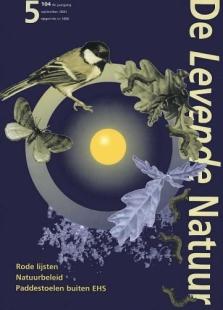De Levende Natuur nummer 5 van 2003 (English summary)
Afbeelding

Ectomycorrhizal fungi as soil-indicator in forest communities on nutrient poor soils
Ozinga, W.A. & E.J.M. Arnolds
Forest communities on nutrient poor soils are poor in higher plants, but in certain conditions they can harbour very high species numbers for ectomycorrhizal-fungi. Combined with the high sensitivity for nitrogen availability ectomycorrhizal-fungi are suitable for the use as soil indicators. A method is presented for the use of indicative mycorrhizal fungi in the mapping of forest communities with a high actual or potential nature-value. The species richness of ectomycorrhizal fungi was mainly restricted to forest-stands with no, or very limited, accumulation of nitrogen rich litter. The effects of some management tools on ectomycorrhizal-fungi are evaluated.
Identification and management of the most important sites for fungi
Brouwer, E. & M.J. van Tweel
Using a national data file that contains more than 1million records about the distribution of fungi, the 200 sites most important to endangered fungi are identified. Most of these sites are nowadays situated on old estates, in the coastal dunes and in woods on nutrient poor and not or weakly acid soils. Trends in the mycological value of these sites are discussed, as well as the possible causes for decline. It is concluded that sites with an international mycological importance are still present, often on unexpected and unprotected places. The authors emphasise the need to pay attention to fungi in nature management, particularly on sites rich in endangered fungi, and offer some practical guidelines.
Management of species-rich hay pastures: Must the application of fertiliser always be rejected?
Oomes, M.J.M. & A. van der Werf
In general one had to be careful with the application of fertiliser on low productive (less than 5 tons per ha per year) species-rich hay pastures. But removal of nutrients over a long period sometimes creates extremely low availabilities of P and K in the soil, and a decrease of the diversity. In that case addition of P and K can be necessary, the amounts that could be applicated are estimated. Data from literature show that a P- and K-content in the biomass of 0.11% and 0.80% indicate a low P- or K-availability in the soil and the limitation of grassland productivity by P or K. Based on a visual estimation of the total annual grassland productivity, the total offtake of P and K can be estimated. We advise to return as fertiliser 50 to 75% of this amount. The paper also shows examples of moderately productive (between 5 and 6 ton), species-rich grasslands that maintain diverse when productivity is raised by PK, P or lime. Especially PK is effective by the stimulation of legumes. No species were lost, the productivity was raised from 4.6 (not fertilised) to 7.2 (PK fertilised). We propose to applicate not more than 100% of the P and K in the hay. This amount can be estimated from the low concentrations of P and K we mentioned above and the annual productivity of this pastures. This combination of higher productivity and high diversity gives an opportunity for multifunctional land use.
Towards harmonisation of Red Lists in Europe
longh, H. de
In Europe more than 2000 Red List publications have been identified, representing some 3,701 Red Lists of threatened species. This large number of Red Lists shows a high diversity and no common approach. The objectives of these Red Lists differ from direct priority setting for nature conservation action to the evaluation of extinction risk only. In addition there are big differences in the taxonomic groups selected, the geographic and administrative scale and range, and methodologies applied. The methodologies include different Categories and Criteria for Red Listing per European country. As a result of these differences the policy impact of Red Lists in Europe is low and Red List species are only to a very limited extent used in European Ecological networks and for the regular updating of the annexes of the Habitat and Bird Directives. In the present article a plea for more harmonisation of Red Lists in Europe is made. One option for more harmonisation is the use of the new IUCN Categories and Criteria (version 3.1.) for threatened species.

